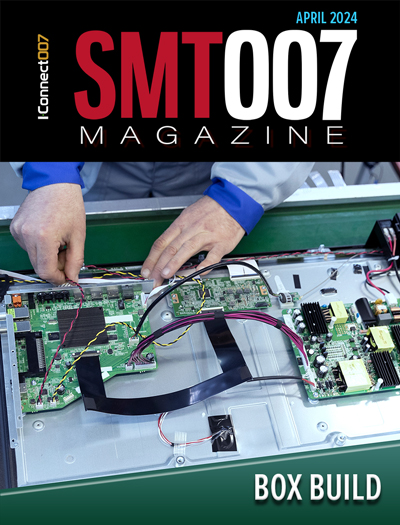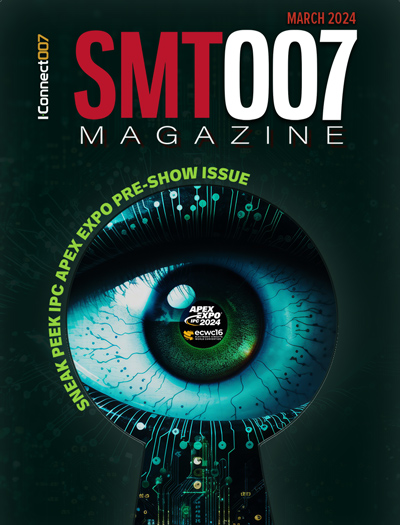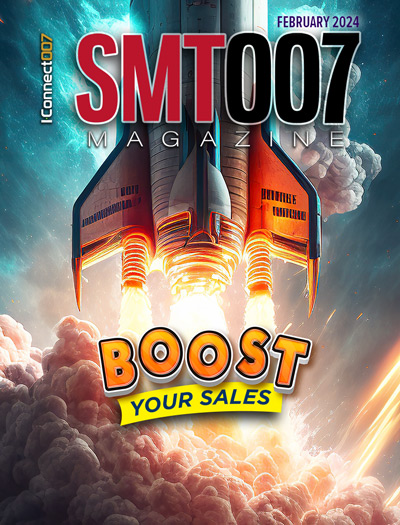-

- News
- Books
Featured Books
- smt007 Magazine
Latest Issues
Current Issue
Box Build
One trend is to add box build and final assembly to your product offering. In this issue, we explore the opportunities and risks of adding system assembly to your service portfolio.

IPC APEX EXPO 2024 Pre-show
This month’s issue devotes its pages to a comprehensive preview of the IPC APEX EXPO 2024 event. Whether your role is technical or business, if you're new-to-the-industry or seasoned veteran, you'll find value throughout this program.

Boost Your Sales
Every part of your business can be evaluated as a process, including your sales funnel. Optimizing your selling process requires a coordinated effort between marketing and sales. In this issue, industry experts in marketing and sales offer their best advice on how to boost your sales efforts.
- Articles
- Columns
Search Console
- Links
- Events
||| MENU - smt007 Magazine
Industry 4.0: Creating a Standard
December 31, 2015 | Barry Matties, I-Connect007Estimated reading time: 18 minutes
In this interview, I sit down with Mentor Graphics Valor Division's Dan Hoz, general manager, and Ofer Lavi Ben David, product line director, to discuss where Industry 4.0 is taking the industry, and the changes it will bring to both large and small companies, customers, and the supply chain, including how Mentor connects different machines on the shop floor to provide universal Industry 4.0 visibility.
Barry Matties: Please start by telling me about your positions at Mentor Graphics and what you're responsible for.
Ofer Lavi Ben David: I'm responsible for the shop floor products from the Valor division of Mentor Graphics.
Dan Hoz: I'm the general manager of the Valor division.
Matties: Good, so what does that mean? I will start with you Ofer.
Lavi Ben David: I look after everything from product development and marketing activities, to sales and business responsibilities for the products within the division. I work with our sales department, our marketing department, and of course our factory R&D resources.
Hoz: I'm the General Manager of the Valor Division within Mentor Graphics. Mentor Graphics acquired us six years ago. I was the CEO and the President of Valor Computerized systems. It was a listed company. The goal or the strategy for Mentor was to get into an adjacent market and expand their solutions—not just within the design market and the design space, but also into other spaces and markets. They found the design for manufacturing flow to be a very interesting one, and so far it has proven to be a successful one.
That was Valor’s strength. Today, we are still a division within Mentor. I'm responsible for both R&D and marketing. We have a direct sales channel, which is the FPO. We also sell through our World Trade organization, which is the largest sales department within Mentor. We also have customer support and a legal department and all the other things we get from the corporate side.
Matties: From the Valor side, obviously you've been affiliated with Mentor for many years. What sort of changes have you seen recently, from your perspective, and what are the real shifts going on there?
Hoz: One of the most recent changes is Industry 4.0. Its six design principles are perfectly aligned with the way we developed our solutions quite a while ago because of business needs that came from our customers. As such, we are a company that can really deliver solutions for Industry 4.0. I'm not just talking about technical solutions, but also at the business level starting from design all the way down to manufacturing. If it's okay with you, I want to show you and walk you through a short presentation.
We are talking about the design for smart factories of the future, and basically the need or the driver in the market is of course to address increased level of complexity and customization, shorten product lifecycle and increase process globalization. This is about designing in one place and manufacturing in the same place versus designing everywhere and building anywhere. The six principles I mentioned are connectivity, decentralization, human-machine interactions, virtualization, modularity and real-time capability. If we talk about connectivity, this is the ability of all the players to connect via the internet of things—I'm talking about humans, machines and factories. Decentralization is also important.
Matties: That's probably the largest area.
Hoz: You're right. This is the ability of systems to make decisions on their own and this is what we calla “single machine factory”. Now, we look at the solutions to support the needs of the six principles. We start with the NPI—a very early stage in the design flow. Taking the design, going down through the machine programming to understand which machines you want to use. You schedule it and then you start manufacturing it. There's process preparation where you do the machine programming, the documentation, and production portability, which is extremely important for this industry 4.0., which is just about software. Industry 3.0 was about hardware.
Matties: It's about software and data.
Hoz: It's about the data—where you can collect the data and then how you normalize the data, so everyone can speak the same language.
Lavi Ben David: In that aspect, I think we are also in a very good position because over the years we have had machine vendors where everyone comes in with their own proprietary interface. What we were doing on the shop floor was connecting and cooperating with those big providers to connect and communicate with their machines and overcome this challenge of a big environment with many protocols, many languages and different capabilities from the machines that are a separate ecosystem in the factory. We are coming to them with our ability to connect those machines and then provide a single, universal communication protocol for these interfaces. I think although we are not an equipment or hardware provider, with our capabilities to connect to the different machines on the shop floor we are in a position to provide this universal Industry 4.0 visibility.
Matties: It sounds like you're coming in as a package or a total solution, from design to completed product.
Hoz: If you look around through software providers that might have an Industry 4.0 solution, most will only talk to you about the manufacturing, per se. We are taking it a few stages earlier, from design. That's the advantage and this is what we call the left shift concept—every time you can identify something at an earlier stage, it will probably save you 10 times the amount it would cost to repair an error detected at later stage.
Yesterday, there was a very nice NES panel discussion here. There were six people talking from different companies and the last question was, "I work through so many processes and so many machine vendors in so many spaces. Everyone speaks different language. Can we have a standard language for everything like in other spaces, like the semiconductor spaces?" In the past, we used a format called ODB ++. That's a very elegant way of saying 'getting the data'. We came up with that. Now we are going to do the same for manufacturing. It's going to be a standard language for everyone that will enable them to get the data, collect the data, normalize it and share it between the different machines.
Page 1 of 4
Suggested Items
Incap Engineer Mentors High School Girls In Stem Leadership Program
01/22/2024 | IncapIn a concerted effort to encourage young girls to pursue careers in STEM, Alicia Kelley, a Program Engineer at Incap US, is serving as a mentor in an initiative that targets high school girls with a passion for science, technology, engineering, and mathematics (STEM).
Movers and Shakers: Brian Chislea of Dow Making a Difference for FIRST Robotics
11/09/2023 | Brian Chislea, The Dow Chemical CompanyMy passion for STEM, mentoring, and our electronics industry is both professional and personal. I’m a scientist and application engineer at Dow Chemical, as well as an IPC standards committee leader and a mentor for burgeoning engineers. Most importantly, my personal life revolves around helping kids become involved in STEM activities, so when I saw an opportunity to be a mentor for my son’s middle school robotics program, I couldn’t pass it up.
Meet the New Workforce at IPS
11/06/2023 | Barry Matties, I-Connect007I recently visited IPS in Cedar City, Utah, which has been manufacturing wet process equipment for printed circuit boards fabrication for more than 30 years. While there, I conducted candid one-on-one interviews with several of the team members. They shared their views on manufacturing, their roles and challenges, their burgeoning passion for what they do, and valuable advice for others looking at manufacturing as a career.
Arrow Electronics Names Rick Marano President of Global Components
08/17/2023 | Business WireArrow Electronics, Inc. announced that Rick Marano will be named president of the company’s global components business, subject to formal Board appointment at the Board’s next regularly scheduled meeting on Sept. 13, 2023.
KT Moore of Cadence Honored with 2023 SEMI Foundation Excellence in Achievement Award for Promoting Workplace Diversity
07/14/2023 | SEMISEMI and the SEMI Foundation, the industry association representing the global electronics design and manufacturing supply chain, announced that KT Moore, Vice President of Corporate Marketing at Cadence Design Systems, has received the 2023 SEMI Foundation Excellence in Achievement Award for his outstanding leadership in promoting diversity, inclusion, equity and belonging (DEIB) and workforce development in the semiconductor industry.


